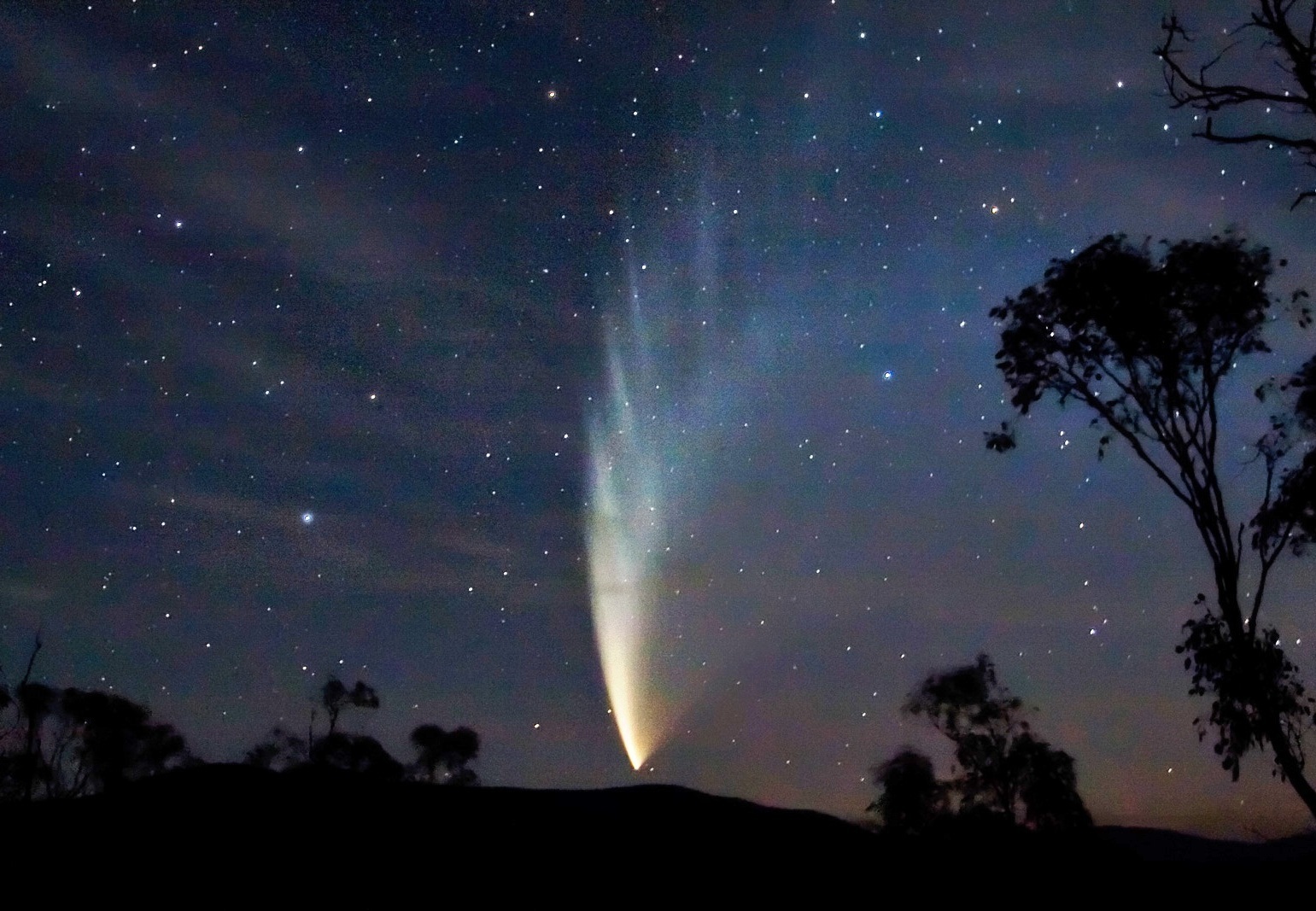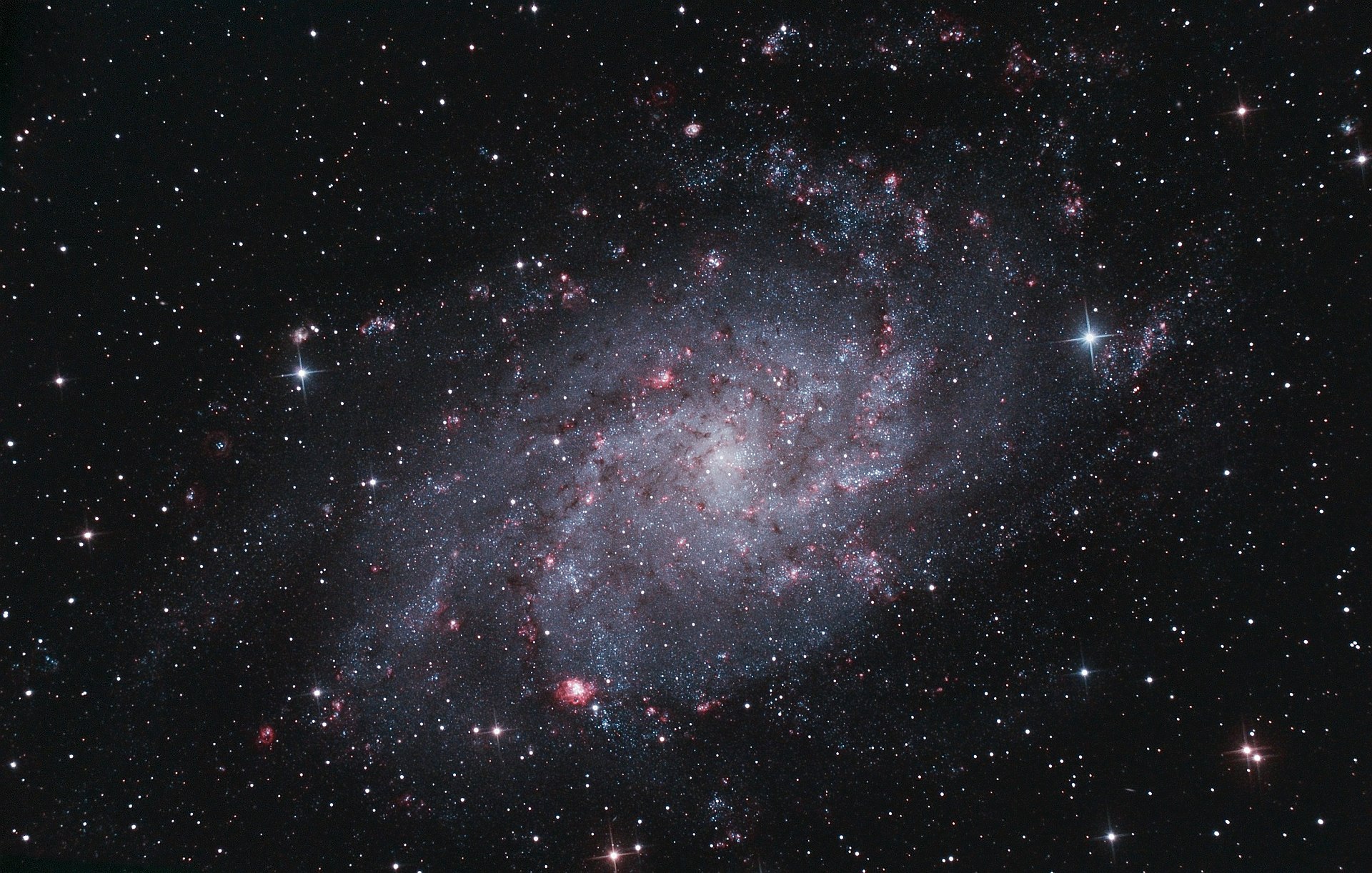2. In Question 1, you derived the Friedmann Equation in a matter-only universe in the Newtonian approach. That is, you now have an equation that describes the rate of change of the size of the universe, should the universe be made of matter (this includes stars, gas, and dark matter) and nothing else. Of course, the universe is not quite so simple. In this question we'll introduce the full Friedmann Equation which describes a universe that contains matter, radiation, and/or dark energy. We will also see some correction terms to the Newtonian derivation.
a) The full Friedmann equations follow from Einstein's GR, which we will not go through in this course. Analogous to the equations that we derived in Question 1, the full Friedmann equations express the expansion/contraction rate of the scale factor of the universe in terms of the properties of the content in the universe, such as the density, pressure, and cosmological constant. The first Friedmann equation (1) is:
\[(\frac{\dot{a}}{a})^2=\frac{8\pi}{3}G\rho-\frac{kc^2}{a^2}+\frac{\Lambda}{3}\]
The second Friedmann equation (2) is:
\[\frac{\ddot{a}}{a}=\frac{-4\pi G}{3c^2}(\rho c^2+3P)+\frac{\Lambda}{3}\]
In these equations, \(\rho\) and P are the density and pressure of the content, respectively. k is the curvature parameter; k = -1, 0, 1 for open, flat, and closed universe, respectively. \(\Lambda\) is the cosmological constant. Note that in GR, not only density but also pressure are the sources of energy.
Starting from these two equations, derive the third Friedmann equation (3), which governs the way average density in the universe changes with time.
\[\dot{\rho}c^2=-3\frac{\dot{a}}{a}(\rho c^2+P)\]
To derive this equation, first multiply \(a^2\) on both sides of (1) and then take time derivative on both sides; plug (2) into your expression to eliminate \(\ddot{a}\).
\(\dot{a}^2=\frac{8\pi}{3}G\rho a^2-kc^2+\frac{\Lambda}{3}a^2\)
\(2\dot{a}\ddot{a}=\frac{8\pi}{3}G[\dot{\rho}a^2+2\rho a\dot{a}]+\frac{2\Lambda}{3}a\dot{a}\)
\(2\dot{a}\frac{\ddot{a}}{a}=\frac{8\pi}{3}G[\dot{\rho}a+2\rho\dot{a}]+\frac{2\Lambda}{3}\dot{a}\)
\(2\dot{a}(\frac{-4\pi G}{3c^2}[\rho c^2+3P]+\frac{\Lambda}{3})=\frac{8\pi}{3}G[\dot{\rho}a+2\rho\dot{a}]+\frac{2\Lambda}{3}\dot{a}\)
Simplify to \(\dot{\rho}c^2=-3\frac{\dot{a}}{a}(\rho c^2+P)\)
b) If the matter is cold, its pressure P = 0, and the cosmological constant \(\Lambda\) = 0. Use the third Friedmann equation to derive the evolution of the density of the matter \(\rho\) as a function of the scale factor of the universe a. You can leave this equation in terms of \(\rho\), \(\rho_0\), \(a\) and \(a_0\), where \(\rho_0\) and \(a_0\) are current values of the mass density and scale factor.
The result you got has the following simple interpretation. The cold matter behaves like “cosmological dust” and it is pressureless (not to be confused with warm/hot dust in the interstellar medium!). As the universe expands, the mass of each dust particle is fixed, but the number density of the dust is diluted - inversely proportional to the volume.
Using the relation between \(\rho\) and a that you just derived and the first Friedmann equation, derive the differential equation for the scale factor a for the matter dominated universe. Solve this differentiation equation to show that \(a(t)\propto t^{2/3}\). This is the characteristic expansion history of the universe if it is dominated by matter.
Determining the density of matter as a function of the scale factor:
\(\dot{\rho}c^2=-3\frac{\dot{a}}{a}\rho c^2\)
\(\frac{d\rho}{dt}=\frac{-3}{a}\frac{da}{dt}\rho\)
\(\int^{\rho}_{\rho_0}\frac{d\rho'}{\rho'}=\int^{a}_{a_0}\frac{-3da'}{a'}\)
\(ln(\frac{\rho}{\rho_0})=-3ln(\frac{a}{a_0})\)
Simplify to \(\rho(a)=\rho_0(\frac{a_0}{a})^3\)
Determining the scale factor for the matter-dominated universe as a function of time:
\((\frac{\dot{a}}{a})^2=\frac{8\pi}{3}G\rho-\frac{kc^2}{a^2}+\frac{\Lambda}{3}\)
\((\frac{\dot{a}}{a})^2=\frac{8\pi}{3}G\rho\) since \(\Lambda\) and k = 0 in the matter-dominated universe.
\(\frac{da}{dt}=(\frac{8\pi}{3}G\rho_0\frac{a_0^3}{a})^{1/2}\)
The right side of the above equation is a constant.
\(\int^a_0a'^{1/2}da'=\int^t_0Cdt'\)
\(\frac{2}{3}a^{2/3}=Ct\) so \(a(t)\propto t^{2/3}\)
c) Let us repeat the above exercise for a universe filled with radiation only. For radiation, \(P=\frac{1}{3}\rho c^2\) and \(\Lambda=0\). Again, use the third Friedmann equation to see how the density of the radiation changes as a function of scale factor.
The result also has a simple interpretation. Imagine the radiation being a collection of photons. Similar to the matter case, the number density of the photon is diluted, inversely proportional to the volume. Now the difference is that, in contrast to the dust particle, each photon can be thought of as wave. As you learned last week, the wavelength of the photon is also stretched as the universe expands, proportional to the scale factor of the universe. According to quantum mechanics, the energy of each photon is inversely proportional to its wavelength: E “ hν. Unlike the dust case where each particle has a fixed energy. So in an expanding universe, the energy of each photon is decreasing inversely proportional to the scale factor. Check that this understanding is consistent with the result you got.
Again using the relation between \(\rho\) and a and the first Friedmann equation to show that \(a(t)\propto t^{1/2}\) for the radiation only universe.
Determining the density of radiation as a function of the scale factor:
\(\dot{\rho}c^2=-3\frac{\dot{a}}{a}(\rho c^2+\frac{1}{3}\rho c^2\)
\(\dot{\rho}=-4\frac{\dot{a}}{a}\rho\)
\(\frac{d\rho}{dt}=\frac{-4}{a}\frac{da}{dt}\rho\)
\(\int^{\rho}_{\rho_0}\frac{d\rho'}{\rho'}=\int^{a}_{a_0}\frac{-4da'}{a'}\)
Simplify to \(\rho(a)=\rho_0(\frac{a_0}{a})^4\)
Determining the scale factor for the radiation-dominated universe as a function of time:
\((\frac{\dot{a}}{a})^2=\frac{8\pi}{3}G\rho_0(\frac{a_0}{a})^4\)
\(\dot{a}^2=\frac{8\pi}{3}G\rho_0\frac{a_0^4}{a^2}\)
\(\frac{da}{dt}=(\frac{8\pi}{3}G\rho_0)^{1/2}\frac{a_0^2}{a}\)
\(\int^a_0a'da'=\int^t_0Cdt'\)
\(\frac{1}{2}a^2=Ct\) so \(a(t)\propto t^{1/2}\)
d) Cosmological constant/dark energy dominated universe. Imagine a universe dominated by the cosmological-constant-like term. Namely in the Friedmann equation, we can set \(\rho=0\) and P = 0 and only keep \(\Lambda\) nonzero.
As a digression, notice that we said “cosmological-constant-like” term. This is because the effect of the cosmological constant may be mimicked by a special content of the universe which has a negative pressure \(P=-\rho c^2\). Check that the effect of this content on the right-hand-side of third Friedmann equation is exactly like that of the cosmological constant. To be general we call this content the Dark Energy. How does the energy density of the dark energy change in time?
Show that the scale factor of the cosmological-constant-dominated universe expands exponentially in time. What is the Hubble parameter of this universe?
Hint: While calculating the scale factor as a function of time, you will find that setting \(a(0)=0\) leads to a negative infinity. Feel free to ignore this term to show the dependence.
The dark energy is a property of spacetime itself, so it remains constant through time.
Determining the scale factor for the dark energy-dominated universe as a function of time:
\((\frac{\dot{a}}{a})^2=\frac{8\pi}{3}G\rho-\frac{kc^2}{a^2}+\frac{\Lambda}{3}\)
\((\frac{\dot{a}}{a})^2=\frac{\Lambda}{3}\) since \(\rho\) and k = 0 in the dark energy-dominated universe.
\(\dot{a}=a(\frac{\Lambda}{3})^{1/2}\)
\(\int^a_0\frac{da'}{a'}=\int^t_0(\frac{\Lambda}{3})^{1/2}dt'\)
\(a(t)=exp(t(\frac{\Lambda}{3})^{1/2})\)
Determining the Hubble parameter:
\(H(t)=\frac{\dot{a}}{a}\) so \(H(t)=(\frac{\Lambda}{3})^{1/2}\)
(e) Suppose the energy density of a universe at its very early time is dominated by half matter and half radiation. (This is in fact the case for our universe 13.7 billion years ago and only 60 thousand years after the Big Bang.) As the universe keeps expanding, which content, radiation or matter, will become the dominant component? Why?
Matter will become the dominant component in this universe as time goes on. The radiation component loses energy not only because the number density decreases as the volume increases, but also because the energy of each individual photon decreases as its wavelength is stretched. This can also be seen mathematically, since at large values for t, the value of the scale factor in the matter-dominated universe (\(a(t)\propto t^{2/3}\)) will be larger than that of the radiation-dominated universe (\(a(t)\propto t^{1/2}\)).
(f) Suppose the energy density of a universe is dominated by similar amount of matter and dark energy. (This is the case for our universe today. Today our universe is roughly 68% in dark energy and 32% in matter, including 28% dark matter and 5% usual matter, which is why it is acceleratedly expanding today.) As the universe keeps expanding, which content, matter or the dark energy, will become the dominant component? Why? What is the fate of our universe?
The energy of dark energy remains constant as the universe expands, whereas the energy of matter decreases as volume increases (the matter gets diluted). Therefore, as the universe expands and matter gets increasingly diluted, dark energy will come to dominate. Our universe will eventually come to be dominated by dark energy as the universe expands enough to make the contributions from matter and radiation negligible.

































.jpg/1920px-Andromeda_Galaxy_(with_h-alpha).jpg)


.jpg/1024px-Irregular_galaxy_NGC_1427A_(captured_by_the_Hubble_Space_Telescope).jpg)

